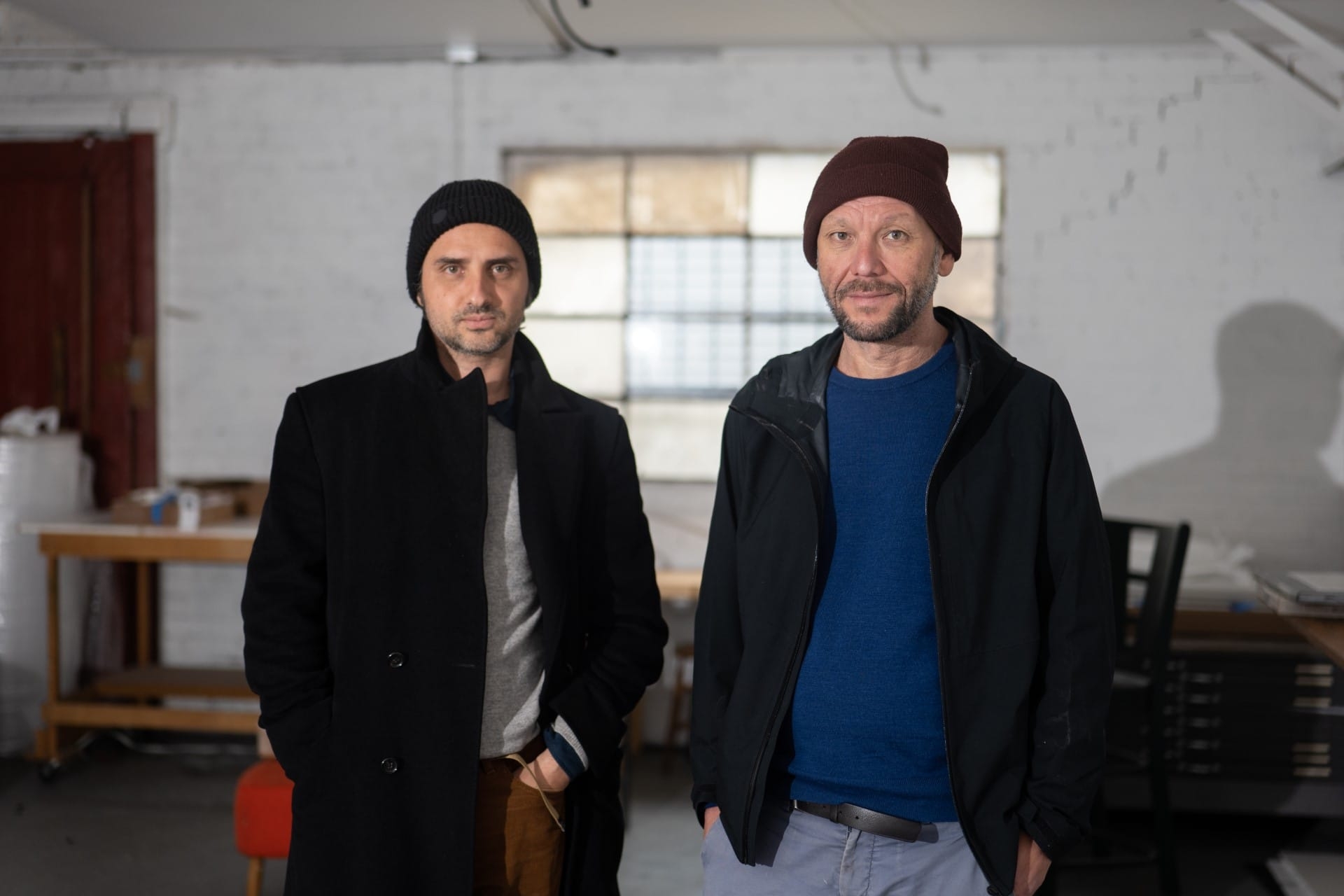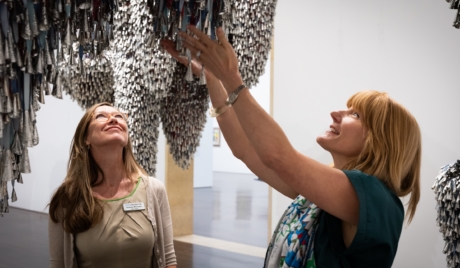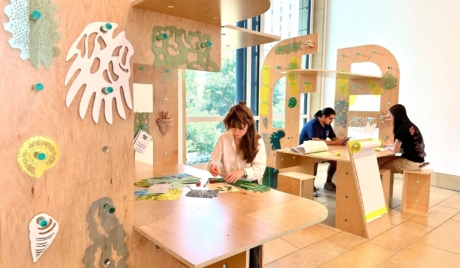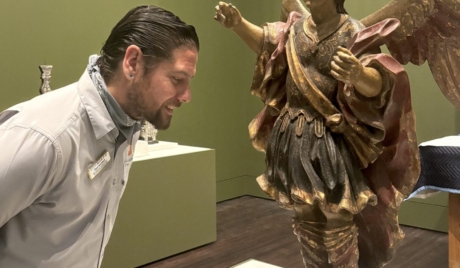
Studio Visit: Kota Ezawa
by Donato Loia, 2022-2023 Andrew W. Mellon Fellow in Modern and Contemporary Art, Blanton Museum of Art
Donato Loia (DL): Kota, thank you for having us visit your studio here in Oakland. Can you tell us more about the path that led you to become an artist? How did art come to you?
Kota Ezawa (KE): “Art coming to me” is the right way to put it because I started at a very young age without knowing what my path would be. People around me told me that art might be my best option, and making art felt natural and came easily to me. I also made music as a teenager.
DL: You studied in Germany and the U.S. Can you tell us about your experience as a student in these countries?
KE: I grew up in the German countryside, just outside Tubingen. After high school, I applied to several art schools and was accepted into the prestigious Art Academy in Düsseldorf, which had world-famous faculty at the time. However, I felt like a deer in the headlights when I arrived. The experience was almost overwhelming. Eventually, I found a cohort that I really liked: the video class under the guidance of Nam June Paik and Nan Hoover. The student body was highly international, and video was a novel medium being taught in art schools, that’s how I started using it. In 1994, I spent a year studying abroad at the San Francisco Art Institute and fell in love with the Bay Area, especially its multiculturalism. I did everything I could to stay here.
DL: One of your most acclaimed works is The Simpson Verdict, which you created in 2002 while pursuing your graduate degree at Stanford. The Simpson Trial was underway when you first arrived in the United States. Could you share more about the impact it had on you, as well as your initial impressions of the US as an immigrant from Europe?
KE: The Simpson trial was a global event. The arrest of O.J. Simpson coincided with the World Cup held in the United States. The car chase interrupted many sports broadcasts, and almost everyone in the world was aware of it. When I moved to the US in 1994, people were already talking about the trial, but I didn’t personally follow it closely. However, I heard people discussing the characters involved in the trial. The verdict was announced when I was a student at the San Francisco Art Institute. Unlike many, I didn’t watch the trial on TV, but instead listened to it on the radio with fellow students. I vividly recall the moment when the verdict was announced, and people were stunned.
DL: Your video work translates the original footage from the Simpson trial into simplified, color shapes while retaining the original audio from the verdict. Can you walk us through how you created this piece? Could you describe your process?
KE: I began working with animation in 2000 and created The Simpson Verdict in 2002. Animation was not a subject I studied in art school; instead, I developed my skills on my own. One of the ways I taught myself animation was by watching animations on TV. I had a two year old child at the time and I remember watching children’s shows like Sesame Street. I recorded sections of these shows and examined them frame by frame to understand how to create movements in a simplified animation style. My goal was never to create something like Pixar or 3D animation. I focused on the technical aspects of 2D cartoons, which I learned from watching children’s animation on TV.
DL: In your video, we hear the original audio of the judge and jury finding Simpson innocent, while the images are stylized and simplified in a cartoon-like style. One thing that stands out to me is the contrast between the audio and video, and the tension created between what we hear and what we see. Can you discuss this tension and how you perceive it?
KE: The initial plan for the animation involved actors reenacting the audio track of the trial. However, as a graduate student working on this project, I had to present work-in-progress versions of the animation to my classmates and professors. In the absence of a recorded soundtrack, I utilized the original track and discovered that there was a real power in doing so. Contemporary cinema typically employs sound that is in sync with the image, but I believe this approach underutilizes the potential of audio. I find that the image and sound are most effective when there is tension between the two. Through the use of highly stylized drawings and raw archival audio, I was able to add tension to the overall experience of the piece.
DL: Animation allows for a more abstract and cartoon-like representation of the figures. However, the trial was a real event with a tragic history. What is the role of stylization in your work, both in general and specifically in this piece?
KE: I developed this drawing style out of necessity. Digital video at the time was still very rough, and low resolution. Solid colors were necessary to compress the video while maintaining image quality. However, I also found that the style had an appealing visual and emotional effect. I have this theory that stylization is directly connected to emotions, and to the emotional response that a viewer can have. My video has the same duration of the original footage, and shows the same event, yet the emotional response to it will be different because of the stylization. This drawing style might also give the impression that the events are presented as fictional. But for me stylization is mostly a way to engage the viewer emotionally.
DL: We are discussing a real event with the Simpson trial, but contemporary media, journalism, and TV tend to sensationalize pain and tragic events. It’s a prevalent phenomenon in our times, and perhaps your work, with its blending of fiction and reality, aims to acknowledge this tendency towards spectacle in the media.
KE: I do not consider my work as a commentary on American culture. As an immigrant who has lived in the United States for a long time, I view my surroundings as an observer with the perspective and distance that immigrants bring to the experience. Yet I am not attempting to dictate how others should view life in the United States. Rather, I simply record and convey my own impressions.
DL: That’s interesting. It reminds me that some people have commented on the racial implications of The Simpson Verdict animation. However, based on your previous response, it seems like you weren’t intentionally commenting on the racial implications of the trial while creating the work.
KE: I considered the racial implications of the Simpson trial, but my approach was different from, let’s say, that of a New York Times journalist. For instance, when you make drawings of people, you realize that everybody has a different skin tone, regardless of their race and ethnicity. That said, my choice of subject matter was intuitive. I wanted to translate archival footage into animation and thought of the footage from the Simpson verdict as a kind of cinema-verité. I was interested in examining the aesthetics of the original recording, which lacked any intentional composition. That said, while showing the work, I learned that the racial subtext is inseparable from the experience of the piece and that probably contributes to its enduring fascination. Despite the trial being seven years in the past when I made the work as a grad student in Northern California, museums all over the West Coast, as well as in New York and Washington, showed it, revealing a continued interest and desire to discuss it.
DL: At times, you described your work as “visual hip hop,” a label that combines music and visual history, and that implicitly refers to a method that in art circles is called “appropriation,” while in music, it’s known as “sampling.” Both techniques involve reusing found images or samples to create new works. Why do you think this approach has become so influential, and how do you relate to this history of sampling?
KE: I am indebted to the history of collage and sampling that goes back as far as Dada and Kurt Schwitters, as well as to early hip hop. Growing up in the 1980s, I was influenced by bands like A Tribe Called Quest and Public Enemy, who popularized the use of sampling in their music and made it into radio stations in southern Germany, where I lived at the time. This idea of deejaying as a visual art practice resonated with me, and I feel like I have a record collection of images at my disposal to create my own mixes and remixes. This is why I refer to my work as “visual hip hop,” not because of any direct connection to the musical genre, but rather as a way to describe my approach as a visual deejay or veejay.
DL: I was considering how this topic could be linked to the history of authorship. In premodern and early modern times, collective authorship was common, as seen in cave paintings and Romanesque cathedrals. Celebrating individual authorship is a modern invention that acquired cult status during the Romantic era. We continue to venerate individual artists today, but, perhaps, we are in a transitional time where celebrating individual authors and recognizing the existence of collective forms of creativity are entering into a stage of a paradoxical dialogue.
KE: Well, it’s a delicate matter. In a way I don’t place much value on authorship. My works don’t bear my signature, and authorship is merely a convention of the art world. Although I don’t have a fixed team of artists, I consider my name to be a placeholder for a collective. I collaborate with artisans to produce some of my work, discuss ideas with others, and use source material contributed by different people. I view my work as a collaborative project, and authorship as a problematic art world convention.
On the other hand, there is a sense in which there is a certain kind of art that is more of a “team sport.” My studio is located just blocks away from Pixar Studios, where hundreds of people work on a single film, and every decision is made by a committee of artists, technicians, and studio executives. I believe that what happens in an art studio is different from what occurs at a company like Pixar. I think that individual voices and individual people still have a lot of influence on artistic output, and allow it to make it more poetic. Conversely, art produced by big corporations may lack this poetic quality since the individual voice is often concealed within collective teamwork.
DL: You mentioned animation earlier. What draws you specifically to animation, and do you consider yourself an animator? In some reviews of The Simpson Verdict, comparisons have been made between your work and South Park, an adult cartoon. Does it surprise you? Would you describe yourself more as an animator or a conceptual artist?
KE: These labels don’t hold much meaning for me. Animation used to be traditionally connected to Saturday morning cartoons, but this is also changing, as they are becoming somehow more experimental. I think it’s fine to call my work animation. The term “conceptual” is a category that is adopted by some people in the arts, but I believe there is a conceptual aspect to most artists’ practices. Andy Warhol considered the physical act of creating the work as the work itself, but he didn’t include thinking as part of the work. For me, thinking is a crucial aspect of the work of an artist, and it requires a lot of time and energy.
DL: Your work has been showcased in major contemporary art exhibitions and biennials, indicating that animation is now fully integrated into the art world circuit. Was it always the case, or did you face any resistance at the beginning of your career in the early 2000s?
KE: My decision to work with animation wasn’t initially inspired by the desire of being a participant in the art world. I was drawn to animation as a medium before considering exhibiting it. Then, it became apparent that galleries and museums were better suited to showcase my work as opposed to film festivals, as animations are short and work well as looped exhibitions. While video may be more challenging for commercial galleries to promote compared to traditional art forms, I never concerned myself with that aspect. I am grateful for the support I’ve received for my work, but I think this positive reception has less to do with the medium itself and more to do with the subject matter and the responses it evokes. It is also true that, with the rise of screen culture, animation has become a logical platform for artists to utilize. Painting and sculpture still hold significance, but animation is part of this generalized interest in screen culture, and that’s where people’s attention lies. I think that’s one of the reasons why artists should incorporate animation into their work.
DL: At the Museum of Modern Art, The Simpson Verdict was displayed alongside an installation piece by Rachel Whiteread, an artist known for creating negative casts of spaces like buildings and libraries that convey a fleeting, ephemeral, and ghostly essence. During a talk, you mentioned that your videos also have a ghostly quality, and you referred to them as “ghost-images.” Could you elaborate on what you mean by a ghost-like image?
KE: It’s an expression that refers to the presence of something outside of the art world. Drawing encompasses various ways of creating an image or line, and my technique involves tracing over forms from photographs or other images. This creates a manual recording of another image, which may be a moving or still image. Although the original image is no longer visible, its ghostly presence remains.
DL: What occurs as you translate the source image to your animations? Perhaps something previously hidden in the original image is uncovered?
KE: I believe that the process of translation involves some loss from the original. Not everything can be retained in the translated version, which becomes a kind of annotated summary. At the same time, something else happens at least for me. When I draw, my eyes take in information from the original and send signals to my hand to move the pen in certain ways. This consciousness of my body becomes infused in the drawing, and it’s something that’s added and not present in the original. The consciousness of the translator enters into the drawing.
DL: Is the act of tracing creating a sense of detachment from the original source? Can you describe your process while working, and is there a meditative quality to your work?
KE: I find that “meditation” is a fitting way to describe my mental process while working. Spending several hours each day for a year on a two-minute video is essentially a meditative practice on an image. I am addicted to this process because it allows me to spend hours each day solely focused on recording an image with my hand. When I don’t have this time, I become agitated. Creating this work has become a necessary habit in my life.
DL: Is there something you hope the viewer gains from your work? Can you imagine an experience or reaction for the viewer?
KE: My ultimate goal is to create a space where the viewer can be moved by the work. But that’s also tricky because there are certain kinds of tools—like sentimental music or emotive colors—that artists might use to move the viewers, and the moment you use them they stop working. I hope that my work can trigger memories or emotions within the viewer. As an artist, I strive to create works that are thought-provoking and encourage self-exploration, rather than relying on cheap emotional tricks. It’s important for me to create a dialogue between the artwork and the viewer, where the artwork serves as a mirror for the viewer’s own experiences and perceptions.



